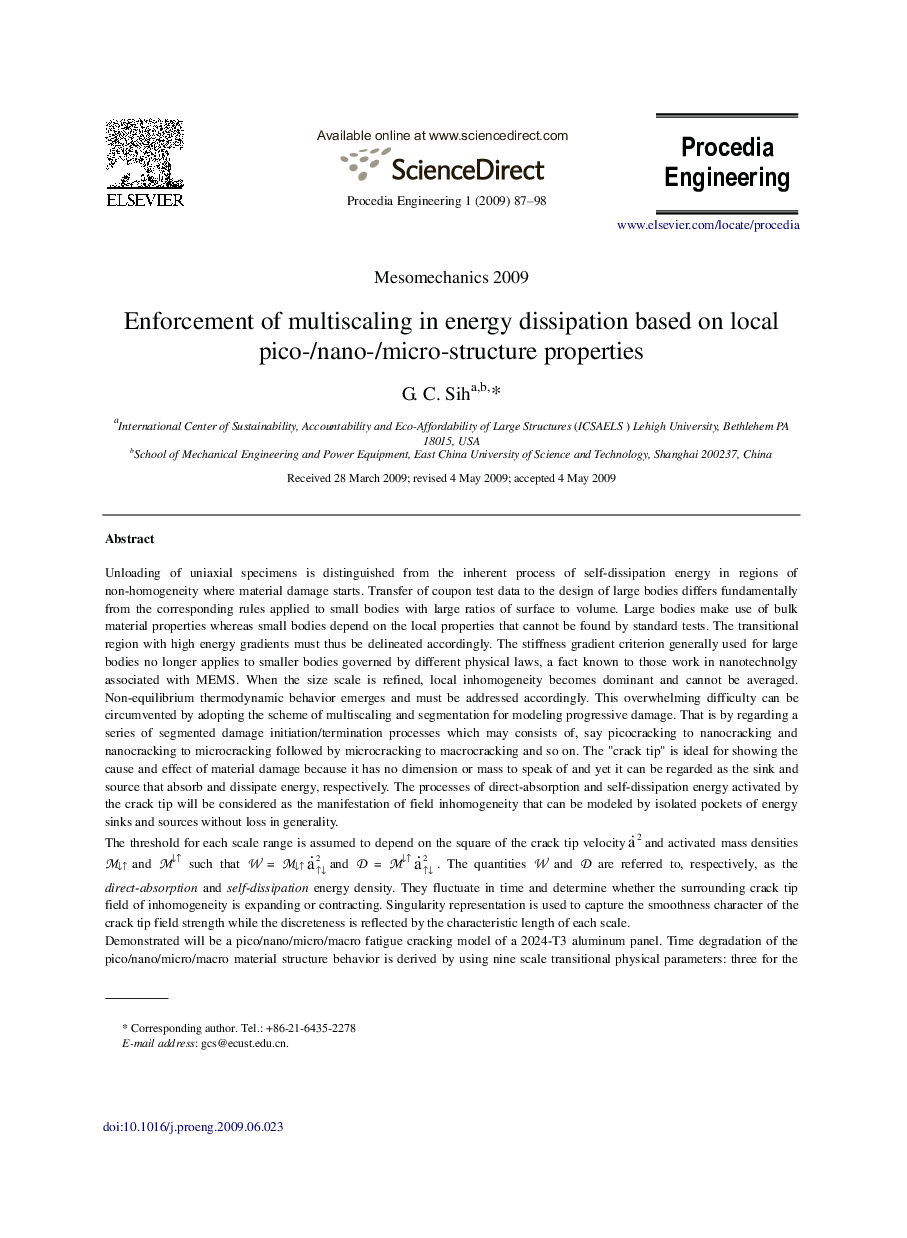| Article ID | Journal | Published Year | Pages | File Type |
|---|---|---|---|---|
| 864553 | Procedia Engineering | 2009 | 12 Pages |
Unloading of uniaxial specimens is distinguished from the inherent process of self-dissipation energy in regions of non-homogeneity where material damage starts. Transfer of coupon test data to the design of large bodies differs fundamentally from the corresponding rules applied to small bodies with large ratios of surface to volume. Large bodies make use of bulk material properties whereas small bodies depend on the local properties that cannot be found by standard tests. The transitional region with high energy gradients must thus be delineated accordingly. The stiffness gradient criterion generally used for large bodies no longer applies to smaller bodies governed by different physical laws, a fact known to those work in nanotechnolgy associated with MEMS. When the size scale is refined, local inhomogeneity becomes dominant and cannot be averaged. Non-equilibrium thermodynamic behavior emerges and must be addressed accordingly. This overwhelming difficulty can be circumvented by adopting the scheme of multiscaling and segmentation for modeling progressive damage. That is by regarding a series of segmented damage initiation/termination processes which may consists of, say picocracking to nanocracking and nanocracking to microcracking followed by microcracking to macrocracking and so on. The ”crack tip” is ideal for showing the cause and effect of material damage because it has no dimension or mass to speak of and yet it can be regarded as the sink and source that absorb and dissipate energy, respectively. The processes of direct-absorption and self-dissipation energy activated by the crack tip will be considered as the manifestation of field inhomogeneity that can be modeled by isolated pockets of energy sinks and sources without loss in generality.The threshold for each scale range is assumed to depend on the square of the crack tip velocity and activated mass densities M↓↑ and M↓↑ such that and . The quantities W and D are referred to, respectively, as the direct-absorption and self-dissipation energy density. They fluctuate in time and determine whether the surrounding crack tip field of inhomogeneity is expanding or contracting. Singularity representation is used to capture the smoothness character of the crack tip field strength while the discreteness is reflected by the characteristic length of each scale.Demonstrated will be a pico/nano/micro/macro fatigue cracking model of a 2024-T3 aluminum panel. Time degradation of the pico/nano/micro/macro material structure behavior is derived by using nine scale transitional physical parameters: three for the pico/nano range (), three for the nano/micro range () and three for the micro/macro range (). The subscripts pi, na, mi and ma designate, respectively, pico, nano, micro, and macro. Only the ratios of two successive scale sensitive parameters need to be known. The time dependent physical parameters at the lower scale are implicit and needed only for analytical continuation.More specifically, the transitional character of picocracks, nanocracks, microcracks and macrocracks are determined from the specified life expectancy of time arrow according to pico→nano→micro→macro with the respective singularity strength of λ given by 1.25/1.00/0.75/0.50. Recall that λ=0.5 corresponds to the inverse square root r−0.5 in fracture mechanics with r being the distance from the macrocrack tip. The microcrack, nanocrack and picocrack tips are assigned with the singularities and and , respectively. The time of arrow in years will depend on the problem definition. Progressive damage is assumed to occur in the direction of pico→nano→micro→macro. The same scheme is applied to the fatigue damage of a 2024-T3 panel with a total life time of 18.5+ to 20 years that may be distributed over the pico. nano, micro, macro and struc. scale according to 1.5+/2.5+/3.5+/5.5+/7.0+. Such a specification can only be satisfied by matching the energy dissipated in damaging the internal material structure at each scale range. Hence, the precise time dependent material property degradation process over the total life span can be enforced.
